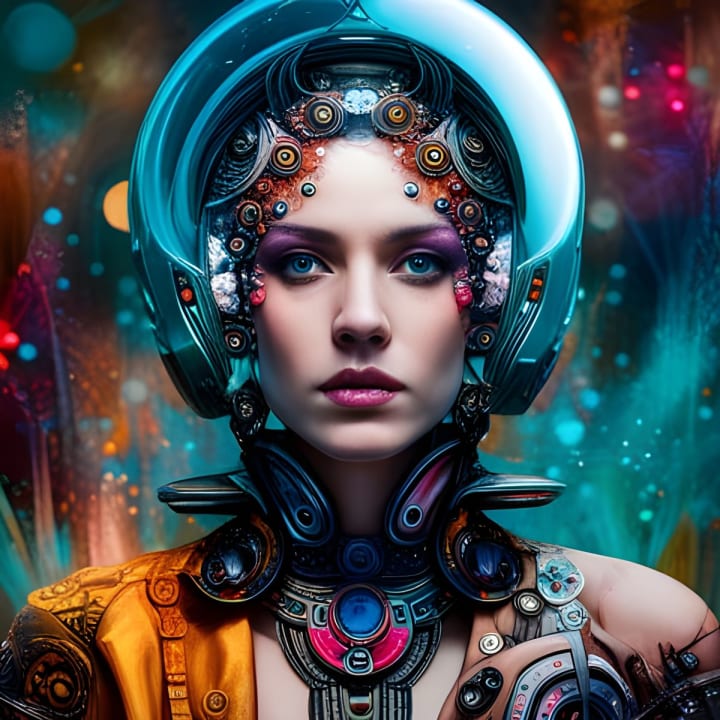Artificial Intelligence in the Creative Arts: Exploring AI-Generated Art and Music
Art and music

Artificial Intelligence (AI) has made significant advancements in the field of creative arts, particularly in the generation of art and music. AI-generated art and music combine computational algorithms with artistic concepts to produce unique and compelling works. Here's an exploration of AI's role in these creative domains:
AI-Generated Art:

1. Style Transfer: AI algorithms can analyze the style of existing artworks and apply those styles to new images. This technique enables the creation of artwork in the style of famous artists like Van Gogh or Picasso.
2. Generative Adversarial Networks (GANs): GANs consist of two neural networks—a generator and a discriminator—that work together to produce new images. GANs have been used to create realistic portraits, landscapes, and abstract art.
3. Neural Style Transfer: By using deep learning algorithms, AI can combine the content of one image with the style of another, resulting in a visually appealing and unique composition.
4. Creative Exploration: AI algorithms can explore vast design spaces, generating novel and innovative visual concepts that may inspire artists and designers.
5. Collaborative AI: Artists and designers often use AI as a tool for inspiration and augmentation, working alongside AI systems to enhance their creative process and generate new ideas.
AI-Generated Music:

1. Music Composition: AI algorithms can compose music by analyzing large datasets of existing compositions, learning patterns, and creating original pieces. Some AI-generated music has been indistinguishable from pieces composed by humans.
2. Harmonization and Accompaniment: AI algorithms can harmonize melodies, generate accompaniments, and compose music in specific genres or styles.
3. Improvisation: AI models can improvise music in real-time by analyzing input parameters, such as mood, tempo, or chord progressions, and generating melodies accordingly.
4. Music Recommendation: AI systems can analyze a person's listening preferences and recommend new music based on their tastes, leading to personalized music experiences.
5. Sound Synthesis: AI techniques like deep learning and generative models can synthesize realistic and expressive sounds, allowing for the creation of new and unique instruments or audio effects.
Ethical Considerations:
While AI-generated art and music offer exciting possibilities, there are ethical considerations to be mindful of:
1. Attribution: Proper credit and acknowledgment should be given to the original creators of the training datasets and algorithms used in AI-generated works.
2. Copyright and Intellectual Property: Clarifying legal frameworks around ownership and copyright of AI-generated art and music can be challenging, as they involve a blend of human and machine contributions.
3. Authenticity and Creativity: Debates arise regarding whether AI-generated works can be considered truly original or if they merely mimic existing styles and ideas.
4. Bias and Representation: AI models can unintentionally perpetuate biases present in training data, reinforcing social and cultural biases in AI-generated art and music. Careful consideration is necessary to ensure fairness and inclusivity.
Certainly! Here are some additional points to further explore the role of AI in the creative arts:
AI-Generated Art:
1. Interactive Art: AI-powered interactive installations and experiences have emerged, where AI algorithms respond to inputs from viewers, creating dynamic and immersive artistic encounters.
2. Augmented Creativity: AI tools can enhance an artist's capabilities by automating repetitive tasks, such as generating complex patterns or filling in details, allowing artists to focus more on conceptualization and expression.
3. Art Restoration: AI algorithms can aid in the restoration and preservation of artwork by analyzing and reconstructing damaged or deteriorated pieces.
4. Artistic Assistance: AI can serve as an artistic assistant, providing suggestions, feedback, and alternative ideas to artists during the creative process, fostering collaboration between humans and machines.
AI-Generated Music:
1. Emotional Composition: AI algorithms can generate music with specific emotional qualities, catering to different moods, atmospheres, or even personalized emotional preferences.
2. Cross-Genre Experimentation: AI models can merge elements from multiple music genres, creating innovative and boundary-pushing compositions that blend styles in new and unexpected ways.
3. Adaptive Music: AI-powered systems can create adaptive soundtracks that respond to changes in user behavior, environmental factors, or interactive elements in video games, virtual reality experiences, or multimedia installations.
4. Music Remixing and Mashups: AI algorithms can analyze and deconstruct existing songs, remixing or mashing them up to create new musical arrangements and combinations.
Challenges and Future Directions:
1. Ethics and Transparency: As AI-generated art and music become more prevalent, establishing clear guidelines and standards for disclosure and transparency about AI involvement in the creative process becomes crucial.
2. Creative Ownership: Determining the rights and ownership of AI-generated works remains a complex issue that requires legal and ethical considerations to protect the interests of both human creators and AI systems.
3. Exploring New Aesthetic Spaces: AI opens up new aesthetic territories that challenge traditional definitions of art and music. Artists and researchers are continuously exploring these new possibilities to push the boundaries of creativity.
4. Human-AI Collaboration: The collaboration between humans and AI systems can foster interdisciplinary interactions and open up new avenues for exploration, with the potential to reshape artistic practices and generate novel artistic expressions.
Overall, AI continues to push the boundaries of creativity in the arts, offering exciting opportunities for artists, musicians, and audiences alike. As technology advances and ethical frameworks evolve, the role of AI in the creative arts is likely to expand, enabling new forms of expression and inspiring further innovation.






Comments
There are no comments for this story
Be the first to respond and start the conversation.